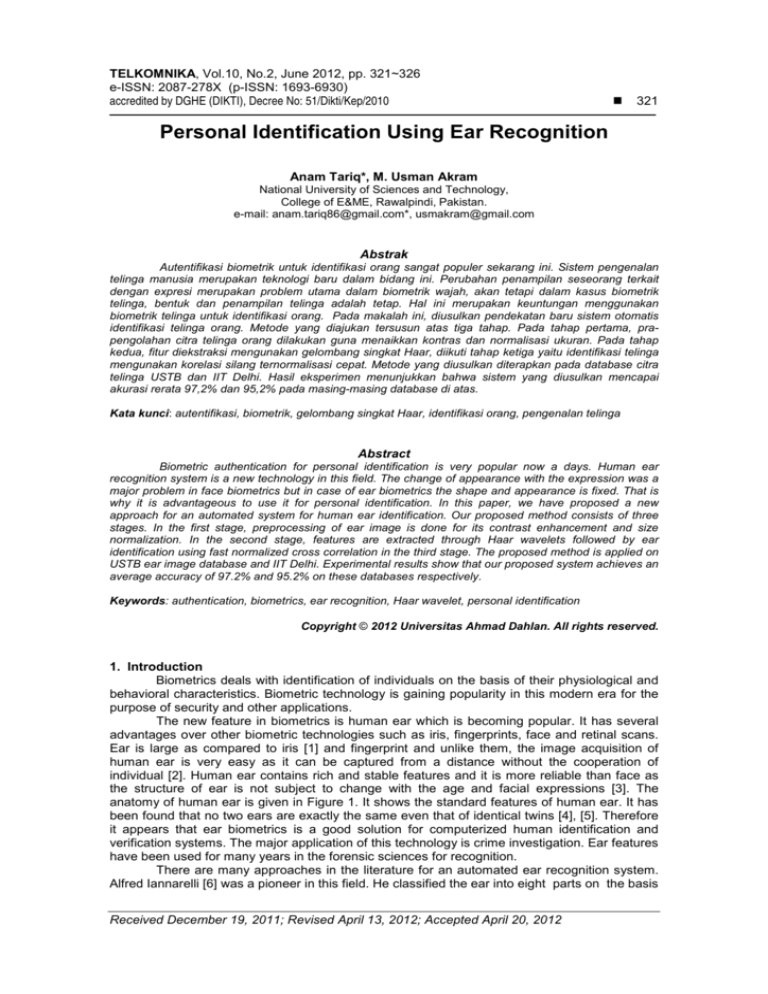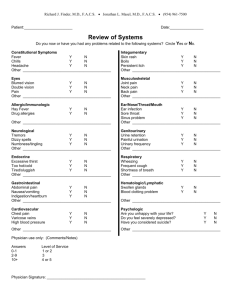
TELKOMNIKA, Vol.10, No.2, June 2012, pp. 321~326
e-ISSN: 2087-278X (p-ISSN: 1693-6930)
accredited by DGHE (DIKTI), Decree No: 51/Dikti/Kep/2010
321
Personal Identification Using Ear Recognition
Anam Tariq*, M. Usman Akram
National University of Sciences and Technology,
College of E&ME, Rawalpindi, Pakistan.
e-mail: anam.tariq86@gmail.com*, usmakram@gmail.com
Abstrak
Autentifikasi biometrik untuk identifikasi orang sangat populer sekarang ini. Sistem pengenalan
telinga manusia merupakan teknologi baru dalam bidang ini. Perubahan penampilan seseorang terkait
dengan expresi merupakan problem utama dalam biometrik wajah, akan tetapi dalam kasus biometrik
telinga, bentuk dan penampilan telinga adalah tetap. Hal ini merupakan keuntungan menggunakan
biometrik telinga untuk identifikasi orang. Pada makalah ini, diusulkan pendekatan baru sistem otomatis
identifikasi telinga orang. Metode yang diajukan tersusun atas tiga tahap. Pada tahap pertama, prapengolahan citra telinga orang dilakukan guna menaikkan kontras dan normalisasi ukuran. Pada tahap
kedua, fitur diekstraksi mengunakan gelombang singkat Haar, diikuti tahap ketiga yaitu identifikasi telinga
mengunakan korelasi silang ternormalisasi cepat. Metode yang diusulkan diterapkan pada database citra
telinga USTB dan IIT Delhi. Hasil eksperimen menunjukkan bahwa sistem yang diusulkan mencapai
akurasi rerata 97,2% dan 95,2% pada masing-masing database di atas.
Kata kunci: autentifikasi, biometrik, gelombang singkat Haar, identifikasi orang, pengenalan telinga
Abstract
Biometric authentication for personal identification is very popular now a days. Human ear
recognition system is a new technology in this field. The change of appearance with the expression was a
major problem in face biometrics but in case of ear biometrics the shape and appearance is fixed. That is
why it is advantageous to use it for personal identification. In this paper, we have proposed a new
approach for an automated system for human ear identification. Our proposed method consists of three
stages. In the first stage, preprocessing of ear image is done for its contrast enhancement and size
normalization. In the second stage, features are extracted through Haar wavelets followed by ear
identification using fast normalized cross correlation in the third stage. The proposed method is applied on
USTB ear image database and IIT Delhi. Experimental results show that our proposed system achieves an
average accuracy of 97.2% and 95.2% on these databases respectively.
Keywords: authentication, biometrics, ear recognition, Haar wavelet, personal identification
Copyright © 2012 Universitas Ahmad Dahlan. All rights reserved.
1. Introduction
Biometrics deals with identification of individuals on the basis of their physiological and
behavioral characteristics. Biometric technology is gaining popularity in this modern era for the
purpose of security and other applications.
The new feature in biometrics is human ear which is becoming popular. It has several
advantages over other biometric technologies such as iris, fingerprints, face and retinal scans.
Ear is large as compared to iris [1] and fingerprint and unlike them, the image acquisition of
human ear is very easy as it can be captured from a distance without the cooperation of
individual [2]. Human ear contains rich and stable features and it is more reliable than face as
the structure of ear is not subject to change with the age and facial expressions [3]. The
anatomy of human ear is given in Figure 1. It shows the standard features of human ear. It has
been found that no two ears are exactly the same even that of identical twins [4], [5]. Therefore
it appears that ear biometrics is a good solution for computerized human identification and
verification systems. The major application of this technology is crime investigation. Ear features
have been used for many years in the forensic sciences for recognition.
There are many approaches in the literature for an automated ear recognition system.
Alfred Iannarelli [6] was a pioneer in this field. He classified the ear into eight parts on the basis
Received December 19, 2011; Revised April 13, 2012; Accepted April 20, 2012
322 e-ISSN: 2087-278X
Figure 1. Anatomy of Human Ear
of 12 measurements. But this method was not suitable because of the difficulty of localization of
anatomical points [6]. Burge and Burger [7] proposed that each individual’s ear is modeled as a
graph of adjacency that can be built using Voronoi diagram of curve segments. For ear
recognition, they have proposed graph matching algorithm which was suitable only for passive
identification. Moreno also proposed a new method for ear recognition based on outer ear
contour’s feature points and information that can be obtained from shape and wrinkles present
in the ear [8]. In [1], Hurley proposed an approach based on force field transform in which the
ear image is considered as an array of Gaussian attractors that act as a source of force field.
The ear is described by small channels by using these directional properties of force field. The
high order moment invariant based technique was used by Wang to extract ear features [9]. Mu
presented a shape and structural feature based ear recognition method for the identification of
persons. This edge based ear recognition method includes edge detection, ear description,
feature extraction that is followed by ear recognition based on the feature vector which has
properties of both outer and inner ear (shape and structure) [10]. The standard PCA algorithm
was used by Chang for ear recognition giving a multimodal approach for ear and face biometric
recognition [5]. Yazdanpanah et al. proposed an ear recognition system using bi-orthogonal and
Gabor wavelet based region covariance matrices approach. They achieved good average
accuracy on USTB database [11]. Daramola et al. proposed an automatic ear recognition
system using energy edge density feature and back propagation neural networks [12].
This paper presents the novel technique for automated human ear recognition system.
There are three steps of the proposed algorithm. In the first step preprocessing is applied on the
ear image which includes its cropping, size normalization and contrast enhancement. In the
second step, features of ear are extracted using Haar wavelet. In the third step of proposed
system feature matching is done using fast normalized cross correlation (NCC) which gives
good results for template matching. Rest of the paper is organized as follows. In section II
proposed ear recognition technology is discussed in detail explaining every step of the system.
Experimental results are discussed in section III and conclusion is given in section IV.
2. Research Method
Figure 2 shows the systematic overview of the human ear recognition technology. In the
first step image is acquired which is then cropped and enhanced in preprocessing stage. In
feature extraction stage, haar wavelet is applied to get the main features of the ear. In the
matching stage, fast normalized cross correlation technique is used for the recognition of human
ear. Each of the components in this figure is described in detail in this section.
2.1. Preprocessing
Preprocessing of ear image is the first stage in our proposed system. Preprocessing is
done to segment out the ear image from the rest of the head portion of a person. Also, size
normalization and ear image enhancement is the requirement of our proposed system before
TELKOMNIKA Vol. 10, No. 2, June 2012 : 321 – 326
TELKOMNIKA
e-ISSN: 2087-278X
323
feature extraction. Images with ear rings, other artifacts and occluded with hairs have not been
processed in this proposed technique.
Figure 2. Human ear recognition technology
The main steps of preprocessing stage are as below:
a. Image is cropped using row and column wise mean based scanning from the head image of
the person.
b. The cropped images are of different sizes. So size normalization of cropped ear images is
done to convert them to a fixed size of 160x120 pixels.
c. The resized images are converted to grayscale.
d. The contrast enhancement of grayscale image is done using contrast limited adaptive
histogram equalization [13]. The main importance of this method is to define a point
transformation within a local large template or window assuming that the intensity value
within that window is a stoical representation of local distribution of intensity value within a
whole ear image. Consider a running subimage W(x,y) of NxN pixels centered on a pixel
P(i,j), the image is filtered with another subimage P(x,y) of NxN pixels according to
equation (1):
[Φw( p) − Φw(min)]
Pn = 255
[Φw(max) − Φw(min)]
(1)
where Фw is defined in equation (2):
µ w − p
Φw( p) = 1 + exp
σ w
−1
(2)
and min and max are the minimum and maximum intensity values in the whole image
respectively. µ w and σ w are the local window mean and standard deviation respectively and
are defined by equation (3) and equation (4) which are as follows:
µw =
σw =
1
N2
1
N2
∑
p (i, j )
( i , j )∈( k ,l )
∑
( i , j )∈( k ,l )
(3)
( p(i, j ) − µ w)2
(4)
This reduces the noise that may be present in the image. Hence the image becomes
clearer after applying this method. Figure 3 shows the preprocessing stage of our proposed
system.
Personal Identification Using Ear Recognition (Anam Tariq)
324 e-ISSN: 2087-278X
Figure 3. Preprocessing: a) original image, b) cropped image, c) resized image, d) contrast
enhanced image
2.2. Feature Extraction
After the preprocessing module, the next stage of human ear recognition system is
feature extraction. Feature extraction is done using Haar wavelet transform [14]. Haar wavelet is
the first known wavelet proposed by Alfred Haar in 1909. Let Ψ:R→R, the mother Haar wavelet
function is defined by equation (5):
1
1, for t ∈ [0, 2 ),
1
Ψ (t ) = −1, for t ∈ [ ,1),
2
0, otherwise.
(5)
and we can generate any Haar function using equation (6)
Ψ i j (t ) = 2 j Ψ (2 t − i )
j
(6)
where i=0,1,….,2j-1 and j = 0,1,….,log2N-1. Now two dimensional Haar wavelet transform can
be computed using equation (7)
N −1 N −1
S (l , m) = ∑∑ I ( x, y ) H (l , x) H (m, y )
x =0 y = 0
(7)
H (2 + i, t ) = Ψ (t )
j
j
i
where I(x,y) is a NxN subimage and
. For the proposed system, we have
used Haar wavelet of level two on the image for its decomposition. The desired features of the
ear are extracted using level two which are then used in the ear matching stage for the
recognition of human ear. Figure 4 shows the feature extraction stage of our proposed system.
2.3. Ear Matching
After extraction of required features from the ear image, matching is done using fast
normalized cross correlation. The basic expression for NCC is given in equation (8) [15].
γ=
∑
∑
x, y
x, y
( I ( x, y) − I u ,v )(t ( x − u, y − v) − t )
( I ( x, y ) − I u ,v )2 ∑ x , y (t ( x − u, y − v) − t )2
I
(8)
where u ,v is the mean value of I(x,y) within the area of template t shifted to (u,v). The simple
NCC based technique suffers from many problems since it is not invariant with respect to
imaging scale, rotation, and perspective distortions. Hence fast NCC is used by taking all the
features from Haar wavelet decomposition in the second stage [15]. A Haar wavelet coefficient
TELKOMNIKA Vol. 10, No. 2, June 2012 : 321 – 326
TELKOMNIKA
e-ISSN: 2087-278X
325
based feature vector is computed for a test image and is correlated with the feature vectors
saved in database. Fast NCC for ear recognition is very significant as it requires less time for
person identification.
3. Experimental Results and Discussion
We have tested our proposed algorithm on University of Science and Technology
Beijing (USTB) ear image database [16] and Indian Institute of Technology (IIT) Delhi ear image
database [17]. USTB ear image database 1 consists of 180 right ear images, three images per
person (60 persons). These images are 8 bit gray scale and under different lighting conditions.
USTB ear image database 2 consists of total 308 right ear images, 4 images per person (77
persons). Four images per person constitutes of one profile image, two images with angle
variation and one image with illumination variation. Each image is 24-bit true color image and
300x400 pixels. The IIT Delhi ear image database is acquired from 125 different subjects and
each subject has at least 3 ear images. The resolution of these ear images is 272x204 pixels.
Figure 5 shows the sample ear images from both these databases.
Table 1 shows the recognition rate of our method on these databases. The average
accuracy on USTB ear database will be 97.2% while 95.2% on IIT ear image database. Results
show that recognition rate on USTB database is good. Table II shows the recognition rate of
different matching approaches of ear recognition technology. Fast NCC performs well among
several different classifiers in less time. Table III shows the average execution time of different
stages of our algorithm. The experiments were carried out on an hp dv-6 workstation with core i5 (2.24 GHz) and with 4GB RAM. MATLAB 7.8 (R2009a) revised version in windows (64-bits)
platform was used for the performance evaluation.
Figure 4. Second level haar wavelet
decomposition of preprocessed ear image
Figure 5. Sample ear images: column a) USTB
ear database, column b) IIT delhi ear database
Table 1. Recognition rate of proposed method on different databases
Database
USTB DB 1
USTB DB 2
IIT Ear Database
No. of subjects
Recognized Ear
Images
59
74
119
60
77
125
Unrecognized Ear
Images
1
3
6
Recognition Rate
(%)
98.33%
96.1%
95.2%
Table 2. Recognition rate of different classifiers
Classifiers
Euclidean distance
Back propogation neural network
Fast normalized cross correlation
No. of
subjects
262
262
262
Recognized Ear
Images
238
250
252
Unrecognized
Ear Images
24
12
10
Recognition Rate
(%)
90.83%
95.41%
96.18%
Personal Identification Using Ear Recognition (Anam Tariq)
326 e-ISSN: 2087-278X
Table 3. Average processing time of different stages of our method
Database
USTB DB 1
USTB DB 2
IIT Delhi Database
Preprocessing
(secs)
0.11
0.23
0.33
Feature
Extraction (secs)
0.03
0.05
0.04
Ear Recognition
(secs)
0.18
0.21
0.23
These results show the soundness of our algorithm and proved that the proposed
system not only provides reliability of the results but also very efficient. Also, our ear matching
approach is better than previous methods.
4. Conclusion
In this paper, a novel approach is presented for an automated human ear recognition
system. The approach consists of three stages such as preprocessing, Haar wavelet based
feature extraction and finally fast NCC based ear feature matching. Experimental results on the
two databases show that our proposed technique is good and effective as it gives better results
than other matching algorithms. The recognition rate is also good than previous approaches for
ear recognition. As for future work of this research, ear localization property should be
integrated in the preprocessing module.
Acknowledgment
The authors would like to thank University of Science and Technology Beijing (USTB)
and Indian Institute of Technology (IIT) Delhi for providing their databases on request for
carrying out this research work.
References
[1]. Arnia F, Pramita N. Enhancement of Iris Recognition System Based on Phase Only Correlation.
TELKOMNIKA, 2011; 9(2): 387-394.
[2]. Hurley DJ, Nixon MS, Carter JN. Force Field Feature Extraction for Ear Biometrics. Computer Vision
and Image Understanding. 2005; 98(3): 491-512.
[3]. Muntasa A, Sirajudin IA, Purnomo MH. Appearance Global and Local Structure Fusion for Face
Image Recognition. TELKOMNIKA. 2011; 9(1): 125-132.
th
[4]. Victor B, Bowyer K, Sarkar S. An Evaluation of Face and Ear Biometric. 16 International Conference
of Pattern Recognition. 2002: 429-432.
[5]. Chang K, Bowyer K, Barnabas V. Comparison and Combination of Ear and Face Image in
Appearance-Based Biometrics. IEEE Transactions on Pattern Analysis and Machine Intelligence.
2003; 25: 1160-1165.
[6]. Lannarelli A. Ear Identification. Forensic Identification Series. California: Paramount Publishing
Company, Fremont. 1989.
th
[7]. Burge M, Burger W. Ear Biometrics in Computer Vision. 15 International Conference of Pattern
Recognition. 2000; 822-826.
[8]. Moreno B, Aanchez A, Velez JF. Use Outer Ear Images for Personal Identification in Security
rd
Applications. 33 International Carnahan Conference. Madrid. 1999: 469-476.
[9]. Zhongli W, Zhichun M, Xiuyan W, Hongtao M. Ear Recognition Based on Moment Invariant Matching.
Pattern Recognition and Artificial Intelligence. 2004; 17(4): 502-505.
[10]. Zhichun M, Li Y, Zhengguang X. Shape and Structural Feature Based Ear Recognition. Advances in
Biometric Person Authentication. Guangzhou, China. 2004; 663-670.
[11]. Yazdanpanah AP, Faez K. Ear Recognition Using Biorthogonal and Gabor Wavelet Based Region
Covariance Matrices. Applied Artificial Intelligence. 2010; 24(9): 863-879.
[12]. Daramola S A, Oluwaninyo OD. Automatic Ear Recognition System Using Back Propagation Neural
Network. International Journal of Video & Image Processing and Network Security, IJVIPNS-IJENS.
2011; 11(1): 28-32.
[13]. Zuiderveld K. Contrast Limited Adaptive Histograph Equalization. Graphic Gems IV. San Diego:
Academic Press Professional. 1994: 474–485.
[14]. Burrus C, Gopinath R, Guo H. Introduction to Wavelets and Wavelet Transforms. New Jersy:
Prentice Hall. 1998.
[15]. Lewis JP. Fast Template Matching. Vision Interface. 1995: 120-123.
[16]. Yuan L, Zhichun M, Zhengguang X. Using Ear Biometrics for Personal Recognition. Advances in
Biometric Person Authentication. LNCS. 2005; 3781: 221-228.
[17]. Kumar A, Wu C. Automated Human Identification Using Ear Matching. Pattern Recognition. 2011.
TELKOMNIKA Vol. 10, No. 2, June 2012 : 321 – 326






